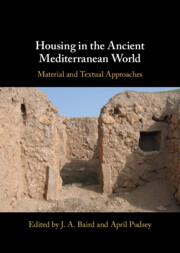Book contents
- Housing in the Ancient Mediterranean World
- Housing in the Ancient Mediterranean World
- Copyright page
- Contents
- Figures
- Tables
- Contributors
- Acknowledgements
- Introduction
- 1 Kinship ‘In the Halls’
- 2 Domesticating the Ancient House
- 3 Mind the Gap
- 4 A Family Affair
- 5 Textiles in Alkestis’ thalamos
- 6 Architectural Rhetoric and the Rhetoric of Architecture
- 7 The Reconstruction of an Agricultural Landscape
- 8 Mudbricks and Papyri from the Desert Sand
- 9 Housing and Community
- 10 The Elusive vestibulum
- 11 Living in the Liminal
- 12 Experiencing Sense, Place and Space in the Roman Villa
- 13 Houses and Time
- 14 Spaces of Desire
- 15 A Response: ‘Using the Material and Written Sources’ Revisited
- Index
- References
Introduction
Between Words and Walls: Material and Textual Approaches to Housing in the Graeco-Roman World
Published online by Cambridge University Press: 08 July 2022
- Housing in the Ancient Mediterranean World
- Housing in the Ancient Mediterranean World
- Copyright page
- Contents
- Figures
- Tables
- Contributors
- Acknowledgements
- Introduction
- 1 Kinship ‘In the Halls’
- 2 Domesticating the Ancient House
- 3 Mind the Gap
- 4 A Family Affair
- 5 Textiles in Alkestis’ thalamos
- 6 Architectural Rhetoric and the Rhetoric of Architecture
- 7 The Reconstruction of an Agricultural Landscape
- 8 Mudbricks and Papyri from the Desert Sand
- 9 Housing and Community
- 10 The Elusive vestibulum
- 11 Living in the Liminal
- 12 Experiencing Sense, Place and Space in the Roman Villa
- 13 Houses and Time
- 14 Spaces of Desire
- 15 A Response: ‘Using the Material and Written Sources’ Revisited
- Index
- References
Summary
This introduction probes the relationship between textual and material approaches to houses of the ancient Mediterranean. Drawing on the contributions to the volume, it traces some of the ways in which documentary and archaeological sources, and the relationships between these, have shaped our knowledge of the housing and households of the Graeco-Roman world.
Keywords
- Type
- Chapter
- Information
- Housing in the Ancient Mediterranean WorldMaterial and Textual Approaches, pp. 1 - 26Publisher: Cambridge University PressPrint publication year: 2022



